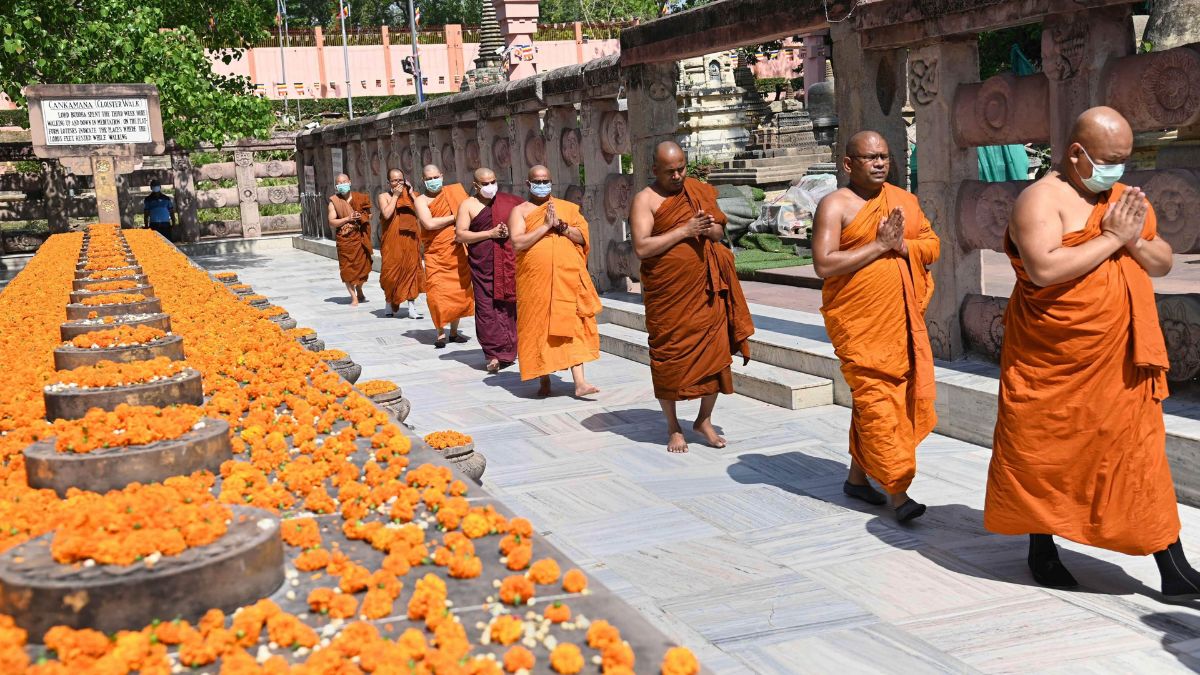Bihar’s Bodh Gaya, one of the holiest places in Buddhism, has been witnessing protests since February. Several Buddhist groups under the umbrella of the All India Buddhist Forum (AIBF) have been protesting to demand the repeal of the Bodh Gaya Temple Act (BTA), 1949.
The protests stem from the yearslong demand by Buddhist monks for the sole control of the Bodh Gaya’s Mahabodhi Temple or Mahavihara, one of the most sacred shrines of Buddhism. Buddha is believed to have attained enlightenment under the Bodhi tree on the premises of the Mahabodhi Mahavihara.
Let’s take a closer look.
History of Mahabodhi Temple
The Mahabodhi Temple was built by Emperor Ashoka in 260 BCE after embracing Buddhism.
The shrine was managed by Buddhists for years until the 13th century when Bakhtiyar Khilji invaded India.
As per Unesco, which has declared it a World Heritage Site, the temple was mostly abandoned between the 13th and 18th centuries, before the British launched renovations.
However, the shrine’s website says that the Hindu monk Ghamandi Giri visited the temple in 1590 and began living there. He started carrying out rituals and established the Bodh Gaya Math.
The temple’s affairs had since been managed by descendants of Giri.
Two years after India’s Independence, the Bihar government enacted the Bodh Gaya Temple Act, transferring the temple’s management from the head of the Bodh Gaya Math to an eight-member committee.
What is Bodh Gaya Temple Act?
The Bodh Gaya Temple Act, 1949, led to the establishment of the Bodhgaya Temple Management Committee (BTMC) in 1953 for the management of the Mahabodhi Temple in Bodh Gaya, Bihar.
The panel has four members from the Buddhist community and four Hindus.
As per the Act, the District Magistrate (DM) of Gaya is an ex-officio chairperson of the committee.
Impact Shorts
More ShortsThe previous provision of the legislation stated that only a Hindu DM could be the ex officio chairperson of BMTC. The Act was amended in 2013 to allow the District Magistrate of Gaya, irrespective of their faith, to head the management committee.
Why are Buddhist monks protesting?
Since February, nearly 100 Buddhist monks have been protesting at the Mahabodhi Temple, which they refer to as Bodh Gaya Mahavihara, calling for rescinding the Bodh Gaya Temple Act.
As per the Frontline magazine, many Buddhist groups under AIBF have been on an indefinite relay hunger strike in Bodh Gaya that began on February 12. They can be seen holding posters with slogans such as “Buddhists demand justice” and “All members of BTMC should be Buddhists”.
These protesters were initially demonstrating at the Mahabodhi Temple. However, on February 27, the over two dozen monks who were on hunger strike were removed by the Bihar police from the temple premises. The protesters had to shift their demonstration outside the holy shrine, reported Al Jazeera.
The demands of the monks include that all members of BTMC should be Buddhists and dissolve the eight-member committee for the management and control of the Mahabodhi Mahavihara.
The protests are reportedly being led by AIBF general secretary Akash Lama and the AIBF president Jambu Lama.
Abhishek Bauddh, who travelled from Chhattisgarh to Bodh Gaya to take part in the agitation, told Al Jazeera that all religions in India “take care and manage their own religious sites”.
“So why are Hindus involved in the committee of a Buddhist religious place?”
Several Buddhist organisations have also organised protests in Mumbai, Mysuru, Delhi and even the United States.
As per Frontline, the protesting Buddhist monks argue the BTA is against the spirit of the Constitution that guarantees the right to profess and practise religion.
Protesters also oppose the Vedic rituals which they say are being increasingly performed by Hindu monks at the temple, defying the principles of Buddhism, reported Al Jazeera.
The Bodh Gaya Math, a Shaivite monastery, performs the rituals inside the Mahabodhi Temple complex and has been responsible for the upkeep of the shrine for centuries.
In a press conference on March 25, the Math dismissed the protests by Buddhist monks as political.
Swami Vivekanand Giri, the current head of the Bodh Gaya Math, alleged that some “politicised people are trying to create social animosity and finish off the existing harmony in the name of Mahabodhi Mandir Mukti Andolan.”
Speaking to Al Jazeera, he claimed the agitations were “politically motivated”, with an eye on the Bihar Assembly elections later this year.
“Our Math’s teachings treat Lord Buddha as the ninth reincarnation of [Hindu] Lord Vishnu and we consider Buddhists our brothers,” Giri said. “For years, we have hosted Buddhist devotees, from other countries as well, and never disallowed them from praying on the premises.”
Previous protests
In 2012, two Buddhist monks filed a writ petition in the Supreme Court to revoke the BTA passed by the Bihar government to resolve the dispute between Buddhist and Hindu heads of the Mahabodhi Temple over its control. The case has not even been listed for hearing yet.
In November 2023, Buddhist monks organised a protest in Bodh Gaya , along with submitting a memorandum to the Central and state governments.
Last September, several monks held a rally in Patna to press the government for repealing the 1949 law.
The AIBF has now reached the Supreme Court and filed an intervention petition, seeking an urgent hearing of the 2012 petition.
It has also given a memorandum to the Bihar government with more than 30,000 signatures as well as the support of over 500 international Buddhist organisations. As per Frontline, the AIBF has proposed to set up the Bodhgaya Mahabodhi Mahavihara Chaitya Trust to replace BTMC.
With inputs from agencies


)

)
)
)
)
)
)
)
)



